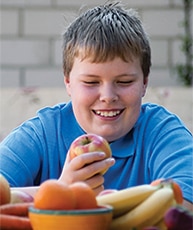Diet Plan for Childhood Obesity
On this page:
- How can I tell if my child is overweight?
- Why should I be concerned?
- How can I help my child develop healthy habits?
- What can I do to improve my child's eating habits?
- How can I help my child be more active?
- Where can I go for help?
- What should I look for in a weight-management program?
- How else can I help my child?
- What are clinical trials and what role do children play in research?
- What clinical trials are open?
As a parent or other caregiver, you can do a lot to help your child reach and maintain a healthy weight. Staying active and consuming healthy foods and beverages are important for your child's well-being. You can take an active role in helping your child—and your whole family—learn habits that may improve health.
How can I tell if my child is overweight?
Being able to tell whether a child is overweight is not always easy. Children grow at different rates and at different times. Also, the amount of a child's body fat changes with age and differs between girls and boys.
One way to tell if your child is overweight is to calculate his or her body mass index (BMI). BMI is a measure of body weight relative to height. The BMI calculator uses a formula that produces a score often used to tell whether a person is underweight, a normal weight, overweight, or obese. The BMI of children is age- and sex-specific and known as the "BMI-for-age."
BMI-for-age uses growth charts created by the U.S. Centers for Disease Control and Prevention. Doctors use these charts to track a child's growth. The charts use a number called a percentile to show how your child's BMI compares with the BMI of other children. The main BMI categories for children and teens are
- healthy weight: 5th to 84th percentile
- overweight: 85th to 94th percentile
- obese: 95th percentile or higher
Why should I be concerned?
You should be concerned if your child has extra weight because weighing too much may increase the chances that your child will develop health problems now or later in life.
In the short run, for example, he or she may have breathing problems or joint pain, making it hard to keep up with friends. Some children may develop health problems, such as type 2 diabetes, high blood pressure, and high cholesterol. Some children also may experience teasing, bullying, depression, or low self-esteem.
Children who are overweight are at higher risk of entering adulthood with too much weight. The chances of developing health problems such as heart disease and certain types of cancer are higher among adults with too much weight.
BMI is a screening tool and does not directly measure body fat or an individual child's risk of health problems. If you are concerned about your child's weight, talk with your child's doctor or other health care professional. He or she can check your child's overall health and growth over time and tell you if weight management may be helpful. Many children who are still growing in length don't need to lose weight; they may need to decrease the amount of weight they gain while they grow taller. Don't put your child on a weight-loss diet unless your child's doctor tells you to.
How can I help my child develop healthy habits?
You can play an important role in helping your child build healthy eating, drinking, physical activity, and sleep habits. For instance, teach your child about balancing the amount of food and beverages he or she eats and drinks with his or her amount of daily physical activity. Take your child grocery shopping and let him or her choose healthy foods and drinks, and help plan and prepare healthy meals and snacks. The 2015 U.S. Dietary Guidelines explain the types of foods and beverages to include in a healthy eating plan.
Here are some other ways to help your child develop healthy habits:
- Be a good role model. Consume healthy foods and drinks, and choose active pastimes. Children are good learners, and they often copy what they see.
- Talk with your child about what it means to be healthy and how to make healthy decisions.
- Discuss how physical activities and certain foods and drinks may help their bodies get strong and stay healthy.
- Children should get at least an hour of physical activity (PDF, 14.2 MB) daily and should limit their screen time (computers, television, and mobile devices) outside of school work to no more than 2 hours each day.
- Chat about how to make healthy choices about food, drinks, and activities at school, at friends' houses, and at other places outside your home.
- Discuss how physical activities and certain foods and drinks may help their bodies get strong and stay healthy.
- Involve the whole family in building healthy eating, drinking, and physical activity habits. Everyone benefits, and your child who is overweight won't feel singled out.
- Make sure you child gets enough sleep. While research about the relationship between sleep and weight is ongoing, some studies link excess weight to not enough sleep in children and adults.1How much sleep your child needs (222 KB) depends on his or her age.

What can I do to improve my child's eating habits?
Besides consuming fewer foods, drinks, and snacks that are high in calories, fat, sugar, and salt, you may get your child to eat healthier by offering these options more often:
- fruits, vegetables, and whole grains such as brown rice
- lean meats, poultry, seafood, beans and peas, soy products, and eggs, instead of meat high in fat
- fat-free or low-fat milk and milk products or milk substitutes, such as soy beverages with added calcium and vitamin D, instead of whole milk or cream
- fruit and vegetable smoothies made with fat-free or low-fat yogurt, instead of milk shakes or ice cream
- water, fat-free, or low-fat milk, instead of soda and other drinks with added sugars

You also may help your child eat better by trying to
- Avoid serving large portions, or the amount of food or drinks your child chooses for a meal or snack. Start with smaller amounts of food and let your child ask for more if he or she is still hungry. If your child chooses food or drinks from a package, container, or can, read the Nutrition Facts Label (PDF, 753 KB) to see what amount is equal to one serving. Match your child's portion to the serving size listed on the label to avoid extra calories, fat, and sugar.
- Put healthy foods and drinks where they are easy to see and keep high-calorie foods and drinks out of sight—or don't buy them at all.
- Eat fast food less often. If you do visit a fast-food restaurant, encourage your child to choose healthier options, such as sliced fruit instead of fries. Also, introduce your child to different foods, such as hummus with veggies.
- Try to sit down to family meals as often as possible, and have fewer meals "on the run."
- Discourage eating in front of the television, computer, or other electronic device.

To help your child develop a healthy attitude toward food and eating:
- Don't make your child clean his or her plate.
- Offer rewards other than food or drinks when encouraging your child to practice healthy habits. Promising dessert for eating vegetables sends a message that vegetables are less valuable than dessert.
Healthy snack ideas
To help your child eat less candy, cookies, and other unhealthy snacks, try these healthier snack options instead:
- air-popped popcorn without butter
- fresh, frozen, or fruit canned in natural juices, plain or with fat-free or low-fat yogurt
- fresh vegetables, such as baby carrots, cucumbers, zucchini, or cherry tomatoes
- low-sugar, whole-grain cereal with fat-free or low-fat milk, or a milk substitute with added calcium and vitamin D
How can I help my child be more active?
Try to make physical activity fun for your child. Children need about 60 minutes of physical activity a day, although the activity doesn't have to be all at once. Several short 10- or even 5-minute spurts of activity throughout the day are just as good. If your child is not used to being active, encourage him or her to start out slowly and build up to 60 minutes a day.

To encourage daily physical activity:
- Let your child choose a favorite activity to do regularly, such as climbing a jungle gym at the playground or joining a sports team or dance class.
- Help your child find simple, fun activities to do at home or on his or her own, such as playing tag, jumping rope, playing catch, shooting baskets, or riding a bike (wear a helmet).
- Limit time with the computer, television, cell phone, and other devices to 2 hours a day.
- Let your child and other family members plan active outings, such as a walk or hike to a favorite spot.
Where can I go for help?
If you have tried to change your family's eating, drinking, physical activity, and sleep habits and your child has not reached a healthy weight, ask your child's health care professional about other options. He or she may be able to recommend a plan for healthy eating and physical activity, or refer you to a weight-management specialist, registered dietitian, or program. Your local hospital, a community health clinic, or health department also may offer weight-management programs for children and teens or information about where you can enroll in one.
What should I look for in a weight-management program?
When choosing a weight-management program for your child, look for a program that
- includes a variety of health care providers on staff, such as doctors, psychologists and registered dietitians.
- evaluates your child's weight, growth, and health before enrollment and throughout the program.
- adapts to your child's specific age and abilities. Programs for elementary school-aged children should be different from those for teens.
- helps your family keep healthy eating, drinking, and physical activity habits after the program ends.
How else can I help my child?
You can help your child by being positive and supportive throughout any process or program you choose to help him or her achieve a healthy weight. Help your child set specific goals and track progress. Reward successes with praise and hugs.
Tell your child that he or she is loved, special, and important. Children's feelings about themselves are often based on how they think their parents and other caregivers feel about them.
Listen to your child's concerns about his or her weight. He or she needs support, understanding, and encouragement from caring adults.
References
What are clinical trials and what role do children play in research?
Clinical trials are research studies involving people of all ages. Clinical trials look at safe and effective new ways to prevent, detect, or treat disease. Researchers also use clinical trials to look at other aspects of care, such as improving quality of life. Research involving children helps scientists
- identify care that is best for a child
- find the best dose of medicines
- find treatments for conditions that only affect children
- treat conditions that behave differently in children
- understand how treatment affects a growing child's body
Find out more about clinical trials and children.
What clinical trials are open?
Clinical trials that are currently open and are recruiting can be viewed at www.ClinicalTrials.gov.
Diet Plan for Childhood Obesity
Source: https://www.niddk.nih.gov/health-information/weight-management/helping-your-child-who-is-overweight


Komentar
Posting Komentar